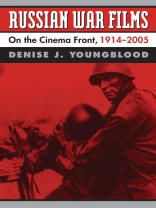Choice Outstanding Title
War movies have long been the most influential genre in Russian cinema, so much so that in the Soviet Union’s militaristic society, ‘cinema front’ was used to describe the film industry itself. Denise J. Youngblood, an internationally recognized authority on Russian and Soviet cinema, provides the first comprehensive guide to this long-neglected genre.
Youngblood explores more than 160 fiction films on Russian conflicts from World War I to Chechnya. These movies represent a wide range of cinematic styles and critical receptions. While not ignoring classic war films like Chapaev and The Cranes Are Flying, Youngblood introduces readers to the films that shaped and reflected Soviet views of war, like the rousing World War II favorite Two Warriors, the Thaw classic The Living and the Dead, and the Brezhnevian extravaganza Liberation. This remarkably humanistic body of work was often at odds with official policies and depicted the futility of war. Youngblood is especially insightful regarding the relationship between Stalinism, Socialist Realism, and filmmakers in creating the war film genre during an era marked by increasing militarization, conformism, and state terror and by the importance of cinema in the World War II propaganda effort. Stalin’s obsession with movies led to the ‘revisioning’ of his role in the Civil War and the ‘Great Patriotic War.’
Yet, Youngblood argues, Soviet filmmakers were not mere puppets of repressive regimes. Indeed, some filmmakers subtly subverted official politics and history in the guise of art or Hollywood-style entertainment. She brings the story to the present by showing how post-Soviet Russian filmmakers have not only turned a critical eye on the recent wars in Afghanistan and Chechnya but are also revisiting the complex realities of World War II.
Youngblood tells a fascinating story that will appeal equally to film aficionados and history buffs. By tracing the evolution of cinema through the twists and turns of both Soviet and post-Soviet society, she helps us understand the role movies played in 20th-century Russia, not only in the making and unmaking of political myths but also in the ‘writing’ of history.
Jadual kandungan
List of Illustrations
Preface and Acknowledgments
Mechanic
Introduction: ‘Waiting for the Barbarians’
1. The Revolutionary Era, 1914-1932
2. Socialist Realism, 1933-1940
3. The Great Patriotic War, 1941-1945
4. From War to the Thaw, 1946-1955
5. The Thaw, 1956-1966
6. The Stagnation, 1967-1971
7. Challenges to Stagnation, 1972-1979
8. To Glasnost and Beyond, 1980-1991
9. After the Fall, 1992-2005
Conclusion: ‘A Kind of Solution’
Filmography
Notes
Bibliography
Index
Mengenai Pengarang
Denise J. Youngblood is professor of history and former vice provost for faculty and academic affairs at the University of Vermont. Her books include Movies for the Masses: Popular Cinema and Soviet Society in the 1920s and The Magic Mirror: Moviemaking in Russia 1908–1918.












